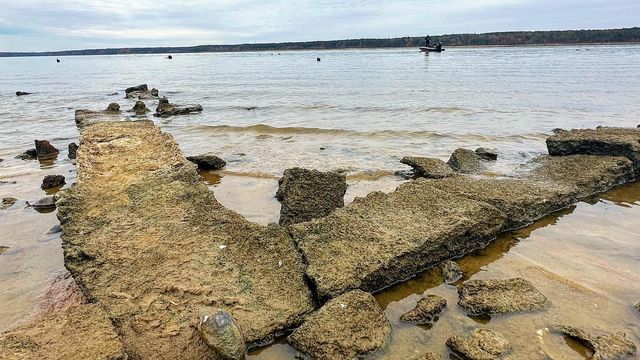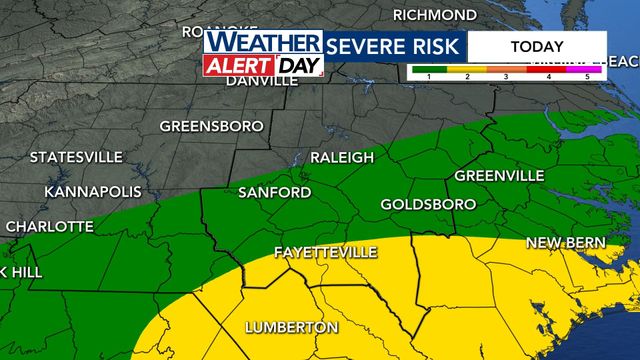Revealed: Drought uncovers hidden remnants of underwater ghost town beneath Jordan Lake
Remnants of an underwater community that has been abandoned and unseen for many years suddenly became visible over the weekend as the murky waters of Jordan Lake sank to unusually low levels – likely due to the recent drought.
Thousands of people pass by Jordan Lake each year, never realizing the ruins hidden just beneath the lake's surface. For years, these ruins have been virtually invisible, but lower water levels recently revealed dozens of artifacts, lost roadways, underwater train tracks and even foundations from the old farm houses that once utilized the rich farmland now lost beneath the lake.
Over the weekend, crowds began visiting the beach for their chance to see the ruins for the first time.

The appearance of these ruins gave a striking perspective on how the lost community was once set up. A crumbling roadway ran along the lake bed, with old gnarled tree stumps appearing in former front yards of the long-lost homes. Just off the roadway were fully-formed foundations of at least two houses, and one smaller foundation that could have been an outhouse. Cinder blocks and bricks littered the beach on either side of the road – remains from other foundations and homes that had not stayed intact. One house even had a perfect stone path leading to the tree, then to the house itself.

The footprint of the ruins provides a perfect outline of how life was once in the old New Hope Valley: Modest farm houses built alongside a country road, with stone pathways and old trees decorating the front yards, and perhaps even an outhouse or two. Nearby, farmers could hear the sound of a passing train – as evidenced by the remnants of underwater train tracks not far from the roadway, which runs parallel to modern day Hwy. 64.
Some families walking along the beach, taking in the sights and history, said their ancestors had once lived and worked a farm on this land. One family, who has lived in the area many years, said some of the houses had been moved from these foundations and could still be seen standing along a nearby country road.

Many of the rural communities that once called that land home – like Seaforth, Pea Ridge and Farrington – have been wiped from the map for decades. However, for a short time, ruins that historians believe to be Seaforth were visible along the same beach where the community once sank beneath the waves – and a little piece of this lost history temporarily re-surfaced.

Jordan Lake was once the New Hope River Valley
Long before European settlers came to the New Hope Valley, indigenous tribes lived on the land for around 10,000 years. A river carved out the valley, creating a landscape that was rich in resources, making it easy to grow food and access water. However, the deep valley also flooded easily – creating a double-edged sword that would eventually end with the destruction of many communities and the creation of Jordan Lake.

When early European settlers arrived in North Carolina in the 1600s, the New Hope River provided a major obstacle to anyone trying to cross the state. Crossing the river was extremely dangerous, forcing most settlers to travel far north or south to go around the river. This barrier made trade between the eastern and western part of North Carolina perilous and expensive.
In the 1700s, a seemingly unlucky farmer named Francis Cypert inherited farmland on both sides of the river valley – forcing him to make that long trek over and over again in order to utilize all of his land. The tide quickly changed for Cypert, however, when he built a toll bridge across the river – a convenience most travelers were happy to pay for. He also built an old 1700s tavern known as Cypert's Tavern, where weary travelers could stay the night and pay for a meal and a drink.

Cypert's Road expanded trade across the state, and eventually grew and developed into a main thoroughfare known as Highway 64.
Given that many of the ruins made visible by the drought are along Highway 64 -- and the roadway revealed beneath the lake this weekend likely part of the original Highway 64 – it's very possible that the original site of his tavern and road have been uncovered by the drought as well.
Why are there so many flooded communities hidden beneath Jordan Lake?
As the centuries passed, many small, unincorporated communities began popping up around the New Hope River Valley. However, while the flood zone made the soil rich for farmers, it also made the area hazardous during storms.
In the 1930s, the US Army Corps. of Engineers surveyed the land, and their examination determined just how treacherous and expensive the flooding could be. Then, in 1945 a hurricane poured over North Carolina for multiple days straight, causing millions of dollars worth of damage.

This time, the government developed a project that would involve building a dam and creating a reservoir to prevent such damaging flooding from happening again. Senator Everette B. Jordan found funding for the so-called New Hope Project in 1963. Over the course of the next few decades, many rural communities were acquired by the government for this project. Some of the homes sat abandoned for years when the project stalled.
In 1982, the lake was finally completed.
Communities like Seaforth, Farrington, Pea Ridge and Friendship were impacted by the rising waters--some were completely flooded. Even today, abandoned homes can be seen decaying in the woods around Jordan Lake's banks.
Many families were unhappy about moving
Many families were unhappy about losing the land they'd lived and worked for generations, according to a newspaper headline from 1964 reading, "New Hope families take dim view of moving."

A editorial published in the N&O pointed out that the government didn't pay enough for the land, which the writer projected would be worth significantly more in the future. They wrote, "The property in the New Hope Valley is wonderfully located -- in a triangle of rapidly growing towns and cities -- Chapel Hill, Durham and Raleigh -- and this property is destined to become very valuable."
They added, "I venture to say within 20 years, much of this property will be worth to its owners from $1,000 to $10,000 an acre, with a total value of $60 million."

One article also pointed out that 15 cemeteries were within the flood zone of the proposed dam.
One writer said they hoped to find a way to allow the 2,000 people residing in the New Hope Valley a way to keep their homes -- and to allow "the bones of our dead to lie unmolested."

it is rare that one gets a peek at the history hidden beneath the surface of these large and deep lakes. Several historians searching the beaches over the weekend discovered old railroad spikes, pieces of old homes and even chipped pieces of pottery and old bowls. If an archaeologist were to explore the lake while levels are low, they may even discover remnants from the Tuscarora tribe that once lived on that same land. Some WRAL viewers who recall growing up on that same land shared their own memories, which came washing back to them after getting a glimpse of the history that's been hidden for so long.
"I can remember when the road [under the water] was flooded and the new road was opened," said one woman.
"We used to race cars on that old road, Old 64, before it was filled in with water. We used to see all of that," said another viewer.
For just a few days, the history beneath Jordan Lake came to the surface once again.
Watch a firsthand exploration of the remnants down on Jordan Lake's beach
Podcast: Explore more underwater ghost towns in North Carolina
Seventh-generation North Carolinian and historian Heather Leah explains several lakes around the state that have ghost towns or other uniqye things hidden underneath in our latest podcast. Take a listen below!
Jordan Lake is far from the only lake to have flooded a rural or struggling community. Many man-made lakes around the state flooded poor, rural or Black communities – including many rural communities beneath Lake Fontana, the lost history of the Harricane beneath Falls Lake and an entire remnant of the Underground Railroad beneath Roanoke Rapids Lake.
- READ MORE: Underwater ghost town: NC lake covers 'lost city' with links to Underground Railroad
- READ MORE: Exploring the abandoned Highway 98 beneath Falls Lake
- READ MORE: Flooded history: Enormous NC lake hides multiple ghost towns
- READ MORE: Road to Nowhere: Abandoned tunnel's history connects to underwater ghost town in NC mountains











